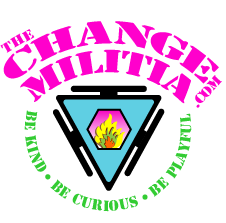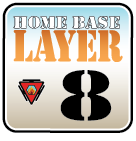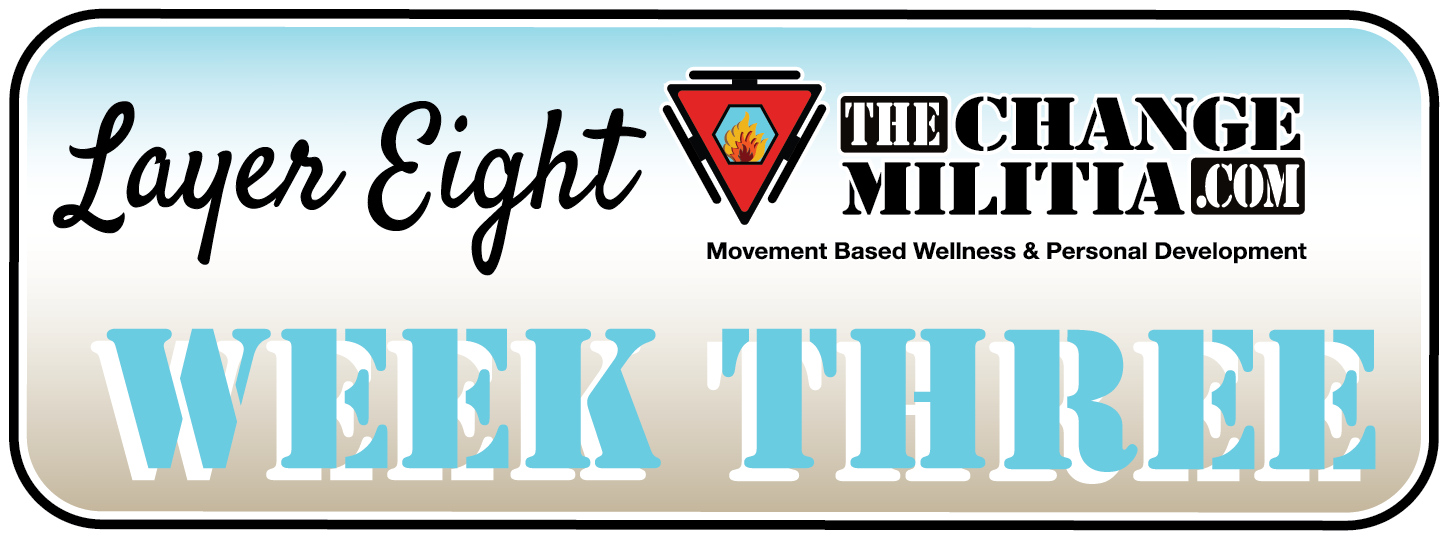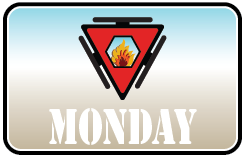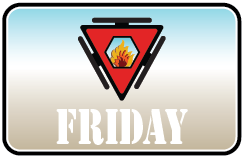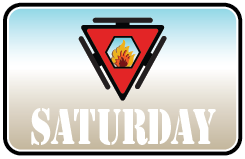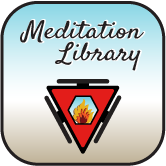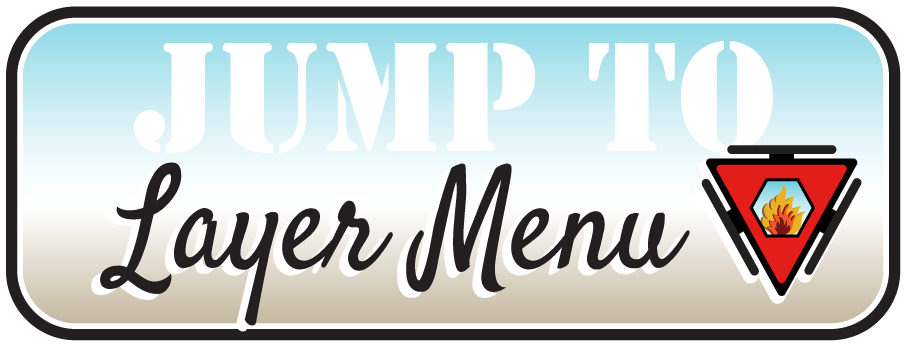Layer Eight, Week Three – Sunday
- Read Week Three Concepts
- Watch video and read descriptions for Body Assessment and Resistance, No Resistance
- Do Meditation – Body Assessment and Resistance, No Resistance
Sunday’s Focus
Spend the day being aware of physical energy entering or leaving your body. Feel temperature changes, light, food, liquid, bodily processes, smells, touch, breath, etc. Begin to recognize the quality and impact physical energy has when it moves.
Sunday’s Concepts
Let’s look at your energetic body and how it influences and is influenced by the other bodies, other people, and your environment.
Consciousness inhabits energy. Your soul resides in your energy body. You become what you do, how you move, and where you change. You are the sum total of your transformations.
Everything in your environment, including your body, mind, emotions, is energy. That energy is always moving. A rock is energy.
Looking at the rock, you wouldn’t think of it as energy moving. During the heat of the day, a rock can absorb a lot of thermal energy from the sun. It stores it and releases it when the ambient temperature is lower than its temperature. Generally, the energy moves from the surface toward the middle during the day and from the middle out at night. The rock absorbs and distributes energy from and to the environment. The rock’s energy is influenced by its environment.
If the rock absorbs more energy than it can store, it crumbles, cracks, explodes or changes its nature. An earthquake is over-energized rock. Graphite under intense pressure and heat can be turned into diamonds. You can even turn your loved ones or pets into diamonds. (Kind of creepy if you ask me but grief is a powerful emotion…)
Your bodies work the same way as the rock. They absorb and distribute energy. Sometimes pressure changes them. Bones break and tissues rupture when there is more energy and pressure than they can absorb. Mental schisms can completely alter personalities. Emotional breakdowns can alter the ability to respond and relate.
Layer Eight, Week Three – Monday
- Read Monday Concepts
- Do Meditation – Body Assessment and Resistance, No Resistance
Monday’s Focus
Feel the energy of your mental processes. Be aware of how ideas, thoughts, images, beliefs, demands, and judgments influence your mental capacity and capability. What gets your mind working more beneficially and what shuts you down or overwhelms you?
Monday’s Concepts
Your physical body absorbs air, water, food, heat, and light. After you absorb things, you digest, store, and discard. When you eat an apple, your digestive system breaks down the apple into its base elements and then absorbs what it can. What it can’t metabolize, it collects and eliminates.
The energy from the apple is converted to energy that is usable at the cellular level. The apple has an energy potential (caloric value) that is freed up and converted during digestion. When the energy from the apple is absorbed by, say, the muscles in your calf, it is then expended when the calf muscle contracts.
Energy in (absorption), energy out (distribution).
Your other bodies absorb, store, and distribute energy too.
Memories are stored energy. You see, hear, feel, taste, smell, or experience something (absorption) and a part of that energy gets stored. When something happens that resonates with stored energy, it gets released.
You are driving along, minding your own business, trying not to text, and you see a big, square RV broken down on the side of the road with a super skinny shirtless guy trying to change a tire and all of a sudden you are transported back to your childhood when the creepy guy from next door asked if you liked gladiator movies. That disturbing recollection is the energy of memories being released … not to mention being vaguely disquieting. You not only remember the event, you remember the feeling of the event.
Tear-jerker movies affect you emotionally because they resonate with your held memories (stored energy). There might not be a direct or conscious correlation, but there is resonance. All energy has specific vibrational components, like a musical chord or riff. When you feel those familiar vibrations, you react in familiar ways.
Layer Eight, Week Three – Tuesday
- Read Tuesday Concepts
- Do Meditation – Body Assessment and Resistance, No Resistance
Tuesday’s Focus
Your emotional energy flows today! Track how your internal or external interactions elicit emotional eruptions. What triggers your held emotional energy to flow? Can you feel what incoming emotional energy feels like?
Tuesday’s Concepts
Riding a bike, bowling, or playing a video game when you haven’t in a while uses a ton of stored energy. Physically, your body recalls the movement sequences necessary, mentally, you remember pertinent details and judgments, and emotionally you remember your emotional connection. You reconfigure your energy to match the current situation.
Energy reconfiguration is the transition from one configuration to another. If you or someone you know is deathly afraid of spiders or mice, recall their state of being before, during, and after an encounter. Before, you or they were doing what you were doing, being who you were being and then EEEEK!, you or they totally reconfigured your energy to focus on the threat. Wikipedia has a great overview of what happens in your body. Click on the link and scroll down to Reaction.
Fear always reconfigures your energy. Recall the last time you were startled, can you remember how it totally changed your bearing, attitude, and posture? The fight, flight, or freeze response is energy reconfiguring to meet a current threat, real or imagined. The energy that triggered the response was stored energy that resonated in some way with a current stimulus (perceived threat). After the trigger, your entire being reacts and is enlisted.
Fear initially focuses your mind and body. If there is an actual threat, your focus will remain until fatigue sets in.
If the threat is imagined, your initial focus will be strong and then your mind will create and add new (imagined) threats since the initial threat is fictional (created by your subconscious mind). There is nothing actual for you to focus on … so your subconscious mind continues to create a plethora of fictitious threats until your energy moderates.
Hysteria and panic are energy configurations brought on by fear triggers and compounding fictions.
After the startled reaction you recalled above, remember how you felt or what you perceived of others. After a fear trigger, animals do something physical to release tension. Ducks shake their bodies, squawk, and flap their wings to release the held tension after an altercation and then they paddle merrily away. What do you do? Most people will laugh, cry, talk, shiver, or stew. My friend Shawn says he perseverates (replays the event over and over). Perseveration can be mental, physical, or emotional but is usually all three. It is a reenactment of the fear event. The perseveration can either refuel the value you are placing on the event or purge the excess energy (like a duck).
Layer Eight, Week Three – Wednesday
- Read Wednesday Concepts
- Do Meditation – Body Assessment and Resistance, No Resistance
Wednesday’s Focus
Spend today finding instances when you can be aware of the simultaneous movements of energy in your physical, mental, and emotional bodies. Take any event and distinguish between the energetic absorption and distribution qualities of each body.
Wednesday’s Concepts
When you retell a story over and over, you are keeping it alive by simultaneously distributing held energy and absorbing and storing energy. The regurgitation and reabsorption of the event refreshes it. One of the ways to release the energy of a held drama, trauma, or story is to NOT talk about it. Feel it in your body when it comes up and then do something physical as you actively relax your mental, emotional and environmental bodies. You will drain the held energy without replacing it. Depending on the value (attachment) you have to it, it may take some repetition of this Kriya (moving meditation) to fully release it.
Let’s talk about how energy moves in each of the bodies so that you get an idea of the relationship of body and energy.
Physical Body – Energy travels in your fluids and through your connective tissue to each of the cells. It also moves as the cells communicate with each other.
Mental, emotional, and environmental energy is absorbed in and around tissues. Butterflies in your stomach or a lump in your throat is non-physical energy impinging and impacting the energy flows of your physical body.
Every cell in your body has a store of physical, mental, emotional, and environmental energies.
When those energies are overwhelming, they trigger some level of fear response. This can occur in a cell, tissue, organ, or area of the body. You feel emotions because the energy of the emotion is being released in non-typical amounts in specific areas of your body.
The lump in your throat happens because energy is expanding both in your chest and your head … your throat is where those expanding energies overlap. As they overlap, the tissues of your throat are overwhelmed and contract as if they were physically threatened.
The normal, everyday, flow of physical energy, is pretty habitual. If you are prone to tension headaches, your tissues have adapted to the belief that they are threatened. In response to that perceived threat, they tense. Tension acts like Chicken Little to the surrounding tissues. Your tension will also Chicken Little the people you come in contact with.
Layer Eight, Week Three – Thursday
- Read Thursday Concepts
- Do Meditation – Body Assessment and Resistance, No Resistance
Thursday’s Focus
Try to feel how your mind influences your physical body. See how many times you can feel your body tense, relax, or freeze after a thought crosses your mind. Feel where your thoughts affect you physically.
Thursday’s Concepts
Mental Body – Mental energy originates in your brain but quickly expands. The thought or idea expands until you (or your subconscious mind) begins to limit, direct, or override it. As it expands, the idea starts looking for resonant energies to connect, merge, or compete with. The resonate energies (stimuli) can be in, around, and/or outside of your body. Your subconscious mind is constantly looking for things that are familiar to help it determine the current threat level.
Let’s say someone in your family is sick. You might start worrying about getting sick. That thought “I don’t want to get sick” begins to expand. As it expands, it feels for other energies that are aligned with worrying, getting sick, being suboptimal, failing, being judged as not enough, low self-image, or negative belief you hold about yourself or others. It looks for similar types of energy.
When the thought connects with similar energies, it merges and then compounds, convolutes, or is redirected by the other energy.
Compound – If you have asthma, your family member’s sickness will probably bring up memories and fears about asthma and asthma attacks. You will worry more about getting sick if you think it is going to trigger your asthma. Your fear of getting sick increases as it interacts with your held fears. Compounding adds energy by recruiting and enlisting other resonate energies.
Redirect – Sickness in the family might trigger judgment toward the family member because they don’t take care of themselves. Worry becomes condemnation. The nature of the energy changes when it comes in contact with strongly held fears that are entrenched. Redirecting changes the emphasis and trajectory of the energy.
Convolute – Their sickness might trigger your intimacy issues. Their sickness becomes a confirmation that it is unsafe to get close to others or allow others to get close. You start out worrying about getting sick and end up thinking about how unsafe it is to allow yourself to powerfully connect with others. Convoluting energy jumps from one configuration to something seemingly unrelated.
Layer Eight, Week Three – Friday
- Read Friday Concepts
- Do Meditation – Body Assessment and Resistance, No Resistance
Friday’s Focus
Track how your mind influences your emotional body. See if you can feel the birth of an emotional label as it is being configured. If you get angry, try to track it from the thought to the completion of the reconfiguration. When you go from not being angry to being angry, your emotional body reconfigures in a habitual sequence. Begin to familiarize yourself with your sequence.
Friday’s Concepts
Emotional Body – Emotional energy coalesces. Your emotional body is a fluid field of energy that constantly reconfigures itself in response or reaction to stimuli. A Plasma Ball is a pretty good visual aid.
It goes something like this. You are chillin’, reading the Atlantic, looking fly in your three-piece double breasted at the local Stealbuck’s with a frosty $18 doublemochafrappelatteswirl and someone sits next to you and places their unadorned coffee in a bring-it-from-home chipped ceramic mug on your postage stamp-sized table before bumping you slightly as they sit.
Your emotional body reacts to the sight of the cup, the strong smell of coffee, and the incursion into your personal space. The cup, the coffee smell, and the bump all elicit different feelings based upon your history and your degree of presence.
If you grew up poor, with an abusive father who took his coffee black and mocked every pansy that didn’t, your emotional body would instantly reconfigure to a set of emotions that would probably evoke shame, anger, sadness, recrimination, and an overwhelming desire to contract and distance yourself. (Redirecting)
If you grew up in a commune with 17 loving sets of Peace Corp Hippy parents who simplified, repurposed, reused, and recycled before it was chic, the coffee cup, smell, and proximity might bring up an overwhelming desire to revert back to the values of your childhood, quit your job, give away your Guccis, and drive your Audi RS7 to the slums of Bogotá where you could sell your car to a drug king-pin’s paramour and dedicate your life to the welfare of orphaned albino alpacas. (Convoluting)
If you are a Militiafarian actively working on increasing your social effusiveness, the cup, smell, and your new table companion will bump you out of your reverie, uplift your spirits, and engage your desire to communicate, collaborate, and confide. You will swoon with the boon as you drop your spoon and loosen your tongue. (Compounding)
The stimulus was the same in each of the examples, the emotional reaction or emotional response was different because the history, habits, and predispositions were different. The first two based their reaction on historical events, the third was based on intention and opportunity. The first two were reactions, the third was a response. The third was a choice and a decision. The first two energy configurations were compressive (the energy built inward), the third was expansive and radiated outward.
Layer Eight, Week Three – Saturday
- Read Saturday Concepts
- Do Meditation – Body Assessment and Resistance, No Resistance
Saturday’s Focus
As you become aware of an emotional reconfiguration, try to identify how, where, and in what sequence your physical body adapts to changing emotional labels.
Saturday’s Concepts
Your emotional body is where you store memories (the energy of the feelings, traumas, images, and beliefs from the past). It is also where you store the energy of your future projections and the future value and demands you place on feelings, traumas, images, and beliefs.
Most if not all of the emotions that you label and feel are brought on by your subconscious mind. It connects present stimuli to some past, present, or future reference and then judges those current stimuli hierarchically.
First, it looks for the strongest resonance, dissonance, or reverberation. It evaluates what in your current environment will react most strongly to some held energy in your emotional body. Then it looks for the second, third, and fourth greatest reaction potential.
After your subconscious mind catalogs, qualifies, and creates a hierarchy, it assigns an emotional label and then reconfigures your emotional body to align with that label.
You are never any emotion until your subconscious mind configures and realigns your emotional body to that label.
The above sentence is critical to your emotional development. Before the label, you existed without the label. There were energies present, stimuli and sensations, that you were feeling without judging, valuing, or qualifying them into some familiar box (label).
Your emotional body is very reactive. By learning to stay present, you will be able to allow and shepherd the energy of your emotional body so that it configures with your intentions and the opportunities that surround you.
You will move from being emotionally reactive to being emotionally responsive.
Next week, you will explore how your energy body responds or reacts with your environment and the people in it.
Body Assessment
Step 1 – Find a comfortable seat. Take a couple of deep breaths and allow yourself to settle.
Step 2 – Make a quick assessment of your physical vitality. Do you feel charged, undercharged, or overcharged?
Step 3 – Charged will be your optimal. Overcharged will be feelings of anxiety, overwhelm, or stress. Undercharged is fatigued, stagnant, or dull.
Step 4 – Charged is the energy running through your system. It will be a feeling, not a mental judgment.
Step 5 – Next, get a little more specific. Ask yourself if your physical body feels vibrant, centered, and optimal.
Step 6 – Determine if you strongly agree, agree, not sure, disagree, or strongly disagree.
Step 7 – Feel into that for a minute and then see if you can come up with a percentage.
Step 8 – Answer the statement “I am at ( )% of optimal.
Step 9 – Redo steps 2-8 as it applies to your mental body.
Step 10 – Redo steps 2-8 as it applies to your emotional body.
Step 11 – Redo steps 2-8 as it applies to your environmental body.
Step 12 – Take those three assessments and establish your trajectory. Are you moving toward or away from optimal? How do your assessments change over the week?
Why it Matters – This meditation will begin to help you feel the energy flows in each of your bodies. It will also start to shift your value from what you think to how your energy is moving in each body.
Everyday Usability – Being able to discern charged, undercharged, and overcharged will remove the stories and projections from your current assessments. When you are judging how optimal each body is, you are present and not focused on the past, others, or the future. You will also be able to discern where your imbalance exists and where you want to focus your rebalancing efforts.
Progression – You will get better, faster, and more accurate as you do this regularly. Familiarity will help you identify changes to your vitality as they are happening.
Resistance, No Resistance
Step 1 – At any time during the day when you feel resistance, when something feels hard or like it is a struggle, try this Kriya (moving meditation).
Step 2 – Stop whatever else you are doing and vigorously clasp and unclasp your dominant hand as fast as you can for 10-15 seconds.
Step 3 – Then completely relax your wrist and vigorously shake your hand for 10-15 seconds.
Step 4 – Stop and ask yourself if you are in a position to allow yourself to do the thing you are resisting. Don’t ask if you still have resistance, ask if you can move forward toward your objective or trajectory.
Step 5 – If you are still not able to overcome your resistance, try it with the other hand while you create an emotional feeling of availability, an allowance for change.
Step 6 – Continue to add body parts to your contract/release and then shake as necessary.
Step 7 – Try to do this every time you feel resistance.
Why it Matters – You are teaching your body to break the resist/stop pattern and replace it with the resist/move pattern. Resistance is your biggest obstacle to success, efficiency, happiness, and fulfillment. When you can disregard resistance as it arises, your progress will be swift and sure.
Everyday Usability – Use this anytime you feel resistance. If you are having trouble allowing yourself to move, try it with something that is just a little bit hard, like getting out of bed or a triple backflip off the roof into a pile of leaves.
Progression – The next step will be to replace the clasp/unclasp and shake with a simple positive step in a beneficial direction.
